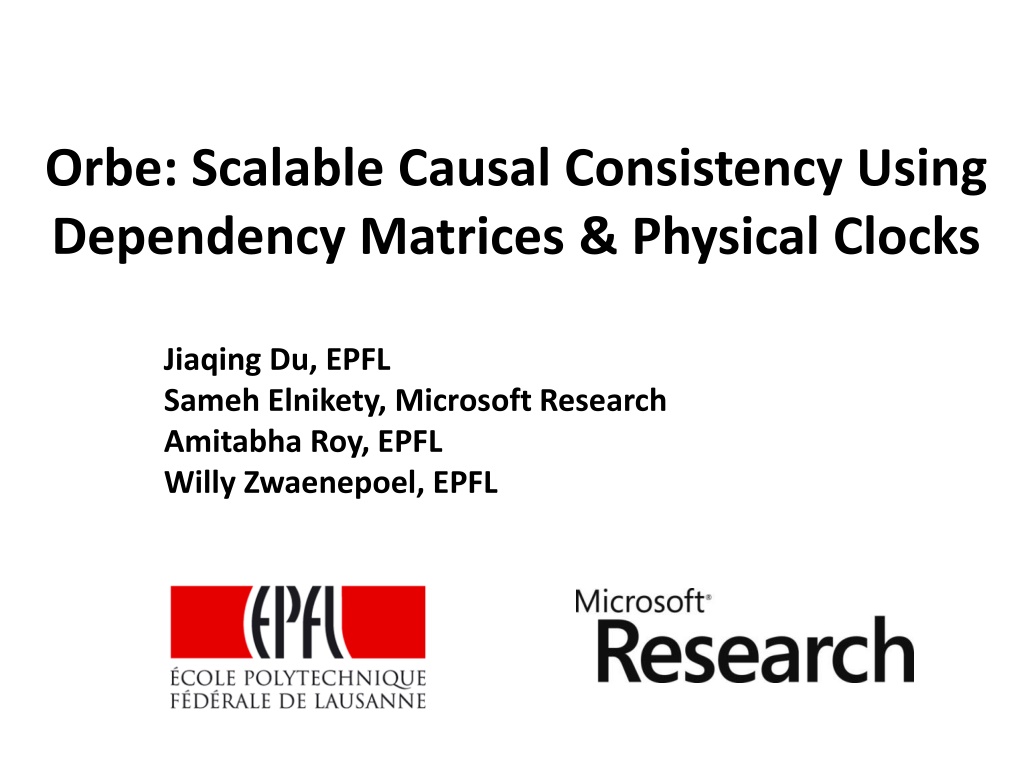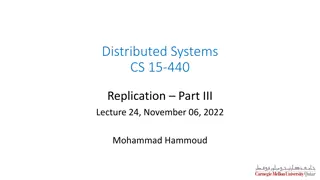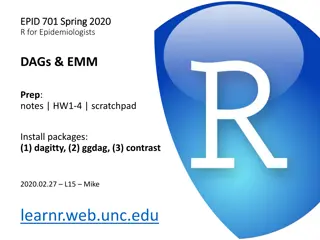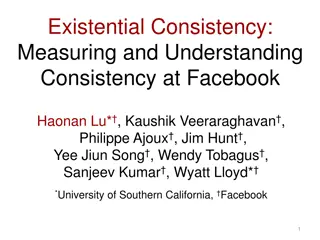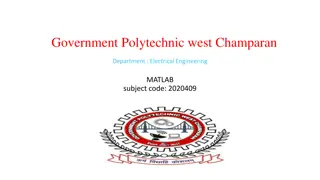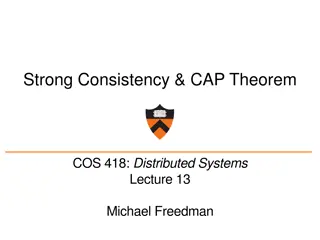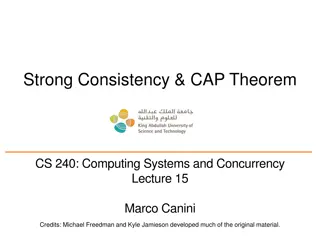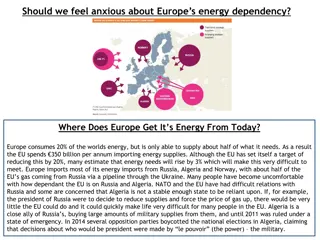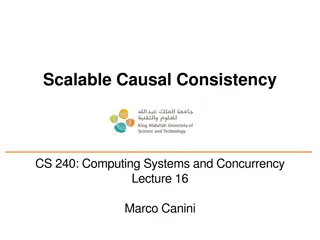Scalable Causal Consistency Using Dependency Matrices
This study explores Orbe, a system that achieves scalable causal consistency through dependency matrices and physical clocks. It discusses key-value data store APIs, partitioning strategies, data center structuring, geo-replication, consistency models, and the implementation of causal consistency in a partitioned and replicated data store.
Download Presentation

Please find below an Image/Link to download the presentation.
The content on the website is provided AS IS for your information and personal use only. It may not be sold, licensed, or shared on other websites without obtaining consent from the author.If you encounter any issues during the download, it is possible that the publisher has removed the file from their server.
You are allowed to download the files provided on this website for personal or commercial use, subject to the condition that they are used lawfully. All files are the property of their respective owners.
The content on the website is provided AS IS for your information and personal use only. It may not be sold, licensed, or shared on other websites without obtaining consent from the author.
E N D
Presentation Transcript
Orbe: Scalable Causal Consistency Using Dependency Matrices & Physical Clocks Jiaqing Du, EPFL Sameh Elnikety, Microsoft Research Amitabha Roy, EPFL Willy Zwaenepoel, EPFL
Key-Value Data Store API Read operation value = get( key ) Write operation put( key, value) Read transaction <value1, value2, > = mget ( key1, key2, ) 2
Partitioning Divide data set into several partitions. A server manages each partition. Partition 1 Partition 2 Partition N 3
Inside a Data Center Data set is partitioned Application Application Application Application tier client client client Data tier Partition 1 Partition 2 Partition N 4
Geo-Replication Data close to end users Tolerates disasters Data Center A Data Center B Data Center C Data Center E Data Center F 5
Scalable Causal Consistency in Orbe Partitioned and replicated data store Parallel asynchronous update propagation Efficient implementationof causal consistency Partition 1 Partition 2 Partition N Replica A Replica B Partition 1 Partition 2 Partition N 6
Consistency Models Strong consistency Total order on propagated updates High update latency, no partition tolerance Causal consistency Propagated updates are partially ordered Low update latency, partition tolerance Eventual consistency No order among propagated updates Low update latency, partition tolerance 7
Causal Consistency (1/3) If A depends on B, then A appears after B. Photo Alice Update Propagation Alice Comment: Great weather! Comment: Great weather! 8
Causal Consistency (2/3) If A depends on B, then A appears after B. Photo Alice Update Propagation Bob Comment: Nice photo! Comment: Nice photo! 9
Causal Consistency (3/3) Partitioned and replicated data stores Client Read(B) Write(C, A+B) Read(A) Partition 1 Partition 2 Partition N Replica A Propagate (C) How to guarantee A and B appear first? Replica B Partition 1 Partition 2 Partition N 10
Existing Solutions Version vectors Only work for purely replicated systems COPS [Lloyd 11] Explicit dependency tracking at client side Overhead is high under many workloads Our work Extends version vectors to dependency matrices Employs physical clocks for read-only transactions Keeps dependency metadata small and bounded 11
Outline DM protocol DM-Clock protocol Evaluation Conclusions 12
Dependency Matrix (DM) Represents dependencies of a state or a client session One integer per server An integer represents all dependencies from a partition first 9 updates Partition 1 Partition 2 Partition 3 9 5 Replica A 0 0 DM Replica B 7 0 first 5 updates Partition 1 Partition 2 Partition 3 13
DM Protocol: Data Structures Dependency matrix (DM) Client 0 0 0 0 DM = 0 0 Partition 1 of Replica A 14
DM Protocol: Data Structures Dependency matrix (DM) Client 0 0 0 0 Version vector (VV) DM = 0 0 Partition 1 of Replica A VV = 3 8 15
DM Protocol: Data Structures Dependency matrix (DM) Client 0 0 0 0 Version vector (VV) DM = 0 0 Source replica id (RID) Partition 1 of Replica A VV = 3 8 1 4 0 0 Item A, rid = A, ut = 2, dm = 0 0 0 5 1 0 Item B, rid = B, ut = 5, dm = 0 0 Update timestamp (UT) 16
DM Protocol: Read and Write Read item Client <-> server Includes read item in client DM Write item Client <-> server Associates client DM to updated item Resets client DM (transitivity of causality) Includes updated item in client DM 17
Example: Read and Write 0 0 0 0 4 0 0 0 0 0 1 0 DM = DM = DM = 0 0 0 0 0 0 Client 4 0 0 0 read(photo) write(comment, ) (ut = 1) (v, rid = A, ut = 4) 0 0 Partition 1 VV = [7, 0] Partition 2 VV = [0, 0] VV = [1, 0] Partition 3 VV = [0, 0] Replica A 18
DM Protocol: Update Propagation Propagate an update Server <-> server Asynchronous propagation Compares DM with VVs of local partitions 19
Example: Update Propagation Partition 1 VV = [7, 0] Partition 2 VV = [0, 0] VV = [1, 0] Partition 3 VV = [0, 0] Replica A 4 0 0 0 replicate(comment, ut = 1, ) 0 0 Replica B check dependency Partition 1 VV = [3, 0] VV = [4, 0] Partition 2 VV = [0, 0] VV = [1, 0] Partition 3 VV = [0, 0] 20
Complete and Nearest Dependencies Transitivity of causality If B depends on A, C depends on B, then C depends on A. Tracking nearest dependencies Reduces dependency metadata size Does not affect correctness A: write Photo B: write Comment 1 C: write Comment 2 Complete Dependencies Nearest Dependencies 21
DM Protocol: Benefits Keeps dependency metadata small and bounded Only tracks nearest dependenciesby resetting the client DM after each update Number of elements in a DM is fixed Utilizes sparse matrix encoding 22
Outline DM protocol DM-Clock protocol Evaluation Conclusions 23
Read Transaction on Causal Snapshot Bob 1 Mom 1 Album: Public Album: Public Photo Photo Bob 2 Bob 3 Album: Public Only close friends! Album: Public Only close friends! Photo Photo Bob 4 Mom 2 Replica A Replica B 24
DM-Clock Protocol (1/2) Provides causally consistent read-only transactions Requires loosely synchronized clocks (NTP) Data structures Client 0 0 0 0 PDT = 0 DM = 0 0 Timestamps from physical clocks Partition 0 VV = 3 8 1 4 0 0 Item A, rid = A, ut = 2, dm = , put = 27 0 0 0 5 1 0 Item B, rid = B, ut = 5, dm = , put = 35 0 0 25
DM-Clock Protocol (2/2) Still tracks nearest dependencies Read-only transaction Obtains snapshot timestamp from local physical clock Reads latest versions created before snapshot time A cut of the causal relationship graph D3 A0 B0 B2 snapshot timestamp C1 C0 E0 26
Outline DM protocol DM-Clock protocol Evaluation Conclusions 27
Evaluation Orbe A partitioned and replicated key-value store Implements the DM and DM-Clock protocols Experiment Setup A local cluster of 16 servers 120 ms update latency 28
Evaluation Questions 1. Does Orbe scale out? 2. How does Orbe compare to eventual consistency? 3. How does Orbe compare to COPS 29
Throughput over Num. of Partitions Workload: Each client accesses two partitions. Orbe scales out as the number of partitions increases. 30
Throughput over Varied Workloads Workload: Each client accesses three partitions. Orbe incurs relatively small overhead for tracking dependencies under many workloads. 31
Orbe Metadata Percentage Dependency metadata is relatively small and bounded. 32
Orbe Dependency Check Messages The number of dependency check messages is relatively small and bounded. 33
Orbe & COPS: Throughput over Client Inter-Operation Delays Workload: Each client accesses three partitions. 34
Orbe & COPS: Number of Dependencies per Update Orbe only tracks nearest dependencies when supporting read-only transactions. 35
In the Paper Protocols Conflict detection Causal snapshot for read transaction Garbage collection Fault-tolerance and recovery Dependency cleaning optimization More experimental results Micro-benchmarks & latency distribution Benefits of dependency cleaning 36
Conclusions Orbe provides scalable causal consistency Partitioned and replicated data store DM protocol Dependency matrices DM-Clock protocol Dependency matrices + physical clocks Read-only transactions (causally consistency) Performance Scale out, low overhead, comparison to EC & COPS 37
